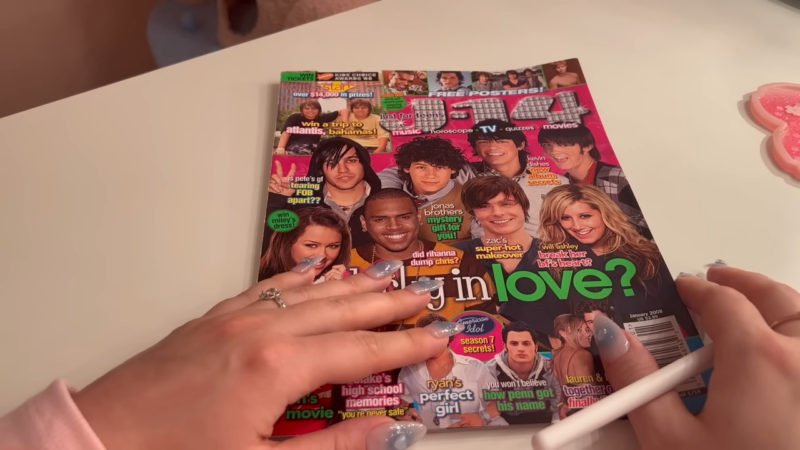Last week, Bop, the teenybopper magazine that’s been churning out covers featuring boy band stock photos splashed atop garish fuchsia backdrops since 1983, announced they would cease publication. If you’re all, “Bop still existed?” you can’t be blamed to assume it had folded years ago. Most teen magazines did.
Of the dozens that have surfaced since the very first teen magazine, Seventeen, was founded in 1944, only four remain: Seventeen, Teen Vogue, J-14, and, assuming some bound pages of prepubescent pin-ups can be classified as a magazine, Tiger Beat.
Here, we look back at all the teen magazines that have folded for one reason (lame cover stars? irrelevant stories? fickle audience?) or another (the internet).
SASSY
Years: 1988–1994
Publisher: Matilda Publications, Lang Communications
Sassy was the Daria to Seventeen’s Quinn. To write it off merely as a teen magazine is doing Jane Pratt’s influential publication a major disservice. It was so much more than that. But with a target audience as young as 13, it was undoubtedly targeted at the same demographic as all the others.
That said, with cover lines like “The Sassiest Boys in Communist China” and “How To Deal If School Bites,” the only thing that girls who subscribed to Sassy had in common with girls who subscribed to Seventeen was their age, and maybe their crushes on Christian Slater.
RIP forever, Sassy.
JUMP
Years: 1996–2001
Publisher: Weider Publications
Back in the ’90s, Weider was the publishing company behind Shape, Men’s Fitness, and Muscle & Fitness. It was founded by a bodybuilder who also manufactured workout supplements. It will come as no surprise to learn that Jump was marketed to “active” teens.
Instead of offering tips for getting skinny and wooing boys, it ran stories about playing sports and being buff. (One summer, my copy of the July issue accompanied me daily to the neighborhood pool so I could do the underwater workout. I still remember what a wrinkled, water-stained mess it was by the time school rolled around. I do not remember whether my legs became “miles-long and toned” or not.)
It wasn’t all about fitness. There was fashion and beauty and quizzes, like any proper teen magazine. Also: lots and lots of giveaways. At one point, they ran a “Free Phone for Your Teen Years Sweepstakes” that rewarded one lucky girl phone service until she was 20, since sharing one phone line with your entire family was the world’s biggest bummer back in 1999.
YM
Years: 1932–2004
Publisher: Gruner + Jahr
In the 1930s, two teen publications — Calling All Girls and Compact — merged and became YM. (Interestingly, Seventeen claims to be the first teen magazine, perhaps because the target audience of Calling All Girls was “girls and subdebs,” not teens.) The original title was an acronym for Young Miss, but it was revamped as Young & Modern under Bonnie Fuller in the ’80s, and reborn once again in 2001 as Your Magazine.
Around that time, they brought on Sassy vet Christina Kelly in hopes that she could breathe new life into its pages. She featured plus-sized models, something no one was doing back then, and published stories about gay proms.
She also announced they’d no longer publish articles about dieting. (The fact that teen mags ever included articles about dieting is sort of appalling, but a peek through eBay reveals that diets weren’t something magazines shied away from, despite having readers as young as 10.)
Sadly, that didn’t do the trick. The magazine folded a few short years after Kelly’s arrival.
TEEN PEOPLE
Years: 1998–2006
Publisher: Time Inc.
After considering a number of magazine titles, including “411,” “The Mix,” and “21 Down” (?!), People’s teen spin-off launched as the sensibly-named Teen People. It was the most successful magazine launch in Time Inc.’s history. Unfortunately, the glory ride didn’t last long. Less than three years after it went to print, founding editor Christina Ferrari resigned and fled to Europe.
(At the time, the New York Post reported on the media move under the headline “FERRARI EXITING TEEN PEOPLE FOR LOVE” — all-caps theirs. She had recently divorced the son of Ruth Whitney, Glamour’s illustrious editor-in-chief, which feels important to include.) A half-dozen top editors rotated in and out in the eight years it was alive, but it never quite bounced back after the original editor left.
The magazine was entirely model-free, and dedicated only one-third of its content to fashion and beauty, balancing frivolity with a mix of profiles about normal high school students doing extraordinary things and celebrities being celebrities (this being a People publication, a certain amount of Hollywood worship is to be expected — gotta hook those readers while they’re young).
And because it was intended for both boys and girls, there was refreshingly little love advice and none of the weird anti-feminism agendas occasionally found in other teen mags. The tagline was “Real teens, real style,” which, ugh. What’s a fake teen? And fake style? But lame slogans aside, it was a quality publication that reported on issues like HIV, bullying, and mental illness.
ELLE GIRL
Years: 2001–2006
Publisher: Hachette Filipacchi
Always a little bit cooler than the others — right down to their “dare to be different” motto — Elle Girl featured actually-rad bands like They Might Be Giants and Rooney, ran street style photography before it was a thing, and once put Mandy Moore and Kelly Osbourne on a cover, together. (Apparently they were good friends in 2002?) They also had a serialized fiction column by a popular YA author and monthly Q&As and cool chicks doing cool things.
Brandon Holley, the former Lucky EIC recently ousted by Eva Chen, served as the founding editor. She departed after a few years to take over at Jane, and Christina Kelly, who was something of a teen magazine wizard by this point, stepped in.
Kelly also did time at Jane, held the top post at YM, and had gotten her start as the music writer at Sassy. (She no longer works in teen magazines, but she does write a hilarious and thoughtful blog.
For a while, it looked like the brand would continue online, a promise consistent among all teen mag shutterings. Every single one assured readers that the brand would keep up its digital presence. Every single one, it goes without saying, failed at this.
When Elle Girl folded, Hachette’s CEO said: “When teen girls are not on the Web, they are on their cells. The company will keep the website and work on Elle Girl ringtones, wallpaper mobile pages and projects in the mobile blogging area.” I don’t know what wallpaper mobile pages are, but I don’t think their relevancy lasted long.
For a short time, Elle Girl partnered with Alloy, a teen media company that at published a magazine of the same name as well as YA books like the Gossip Girl series, to try to stay afloat online. Alloy is now a clothing company that sells the kind of body-con dresses and platform heels that Courtney Stoddard wears. Needless to say, that partnership faded very quickly.
COSMOGIRL
Years: 1999–2008
Publisher: Hearst
Hearst founded CosmoGirl at an interesting time. Fellow publisher Primedia was putting out not one but two successful teen mags, and Time Inc.’s Teen People and Gruner + Jahr’s YM were both still going strong. (Conde Nast unveiled their first test issue of Teen Vogue a few months later. Nick Lachey and Jessica Simpson covered the issue. I still have my copy if you’d like to borrow it.)
As the story goes, Atoosa Rubenstein, a young fashion editor at Cosmopolitan, was asked to make a mock issue for their yet-to-be-named teen spin-off. She mindlessly scrawled the word “Girl!” across the cover of a recent issue using hot pink lipstick. That become the title and the logo for the magazine.
Just 26 at the time, Rubenstein became an icon for teen girls. The antithesis of Anna Wintour, she wrote her editor’s letters about awkward adolescent moments and always included a childhood snapshot of herself — braces, frizz, unibrow — alongside a more current and glossy-haired photo.
Considering it was based on a salacious magazine pedaling endless ways to please a man and sexy clothes he can’t resist, the teen version was actually pretty smart.
TEEN
Years: 1954–2009
Publisher: Emap Peterson, Primedia, Hearst
Exactly 10 years after Seventeen hit newsstands, the generically-named and impossible-to-Google Teen was founded. At one point, it was the longest-selling teen magazine, but it never had much of a personality. It was the girl in school who wanted to be in the popular clique, but fell somewhere between the junior varsity cheerleaders (but not varsity and certainly not on the dance team) and the glee club (but not Dianna Agron and certainly not Lea Michele).
With headlines like, “How Hot Can You Get?” and “Quiz: Are You Guy Obsessed?” it focused heavily on looking good to land a boyfriend. It was also the kind of magazine that used stock photos instead of doing photoshoots for each issue. They may or may not have occasionally simply used the wax figures of celebrities.
In 2003, Hearst decided it’d be a good move to spend $182.4 million dollars to buy Teen and Seventeen from Primedia, even though they’d only launched CosmoGirl, catering to the exact same audience, four years prior. This did not go well. Five years later, Cosmogirl folded, and the next year, Teen was killed.
BOP
Years: 1983–2014
Publisher: Laufer Media
Known mostly for their fold-out posters of JTT and a propensity for heart-shaped graphics, Bop is like a kid’s version of Star, the magazine your great aunt buys at the supermarket when she’s stocking up on Ensure and Nilla Wafers.
There’s truly no discernible difference between Bop and Tiger Beat, both of which share a publisher and a URL. The case could be made that Bop is more teeny-bopper, because of its name, but it’s impossible to make a comparison against a name like Tiger Beat, because what does that even mean?
Regardless, both have been published monthly since 1983. Well, until now.
FAQ
What impacts did teen magazines have on fashion trends?
Teen magazines often set fashion trends, influencing their readers’ styles with featured clothing, accessories, and beauty products.
How did teen magazines shape pop culture over the years?
Teen magazines played a significant role in shaping pop culture, highlighting emerging artists, actors, and trends, thus influencing youth culture.
Are digital versions of teen magazines as impactful as print versions were?
Digital versions reach a broader audience but often lack the tangible, collectible appeal of print magazines, impacting how content is consumed and valued.
How have social media platforms replaced the role of teen magazines?
Social media platforms provide real-time, interactive content and celebrity access, filling the gap left by teen magazines in pop culture and fashion guidance.
What were the challenges teen magazines faced with the rise of the internet?
Teen magazines struggled to adapt to the digital age, facing challenges in maintaining print sales and transitioning to online platforms effectively.
How did teen magazines influence youth activism and awareness?
Many teen magazines highlighted social issues, encouraging activism and awareness among young readers on topics like environmentalism, equality, and mental health.
Did any teen magazines focus exclusively on music or film?
While most teen magazines covered a broad range of topics, some specialized in music or film, heavily featuring musicians, bands, or movie stars.
Final Words
As we bid farewell to the iconic era of teen magazines, we celebrate their indelible mark on generations, forever cherished in the annals of pop culture and youthful nostalgia.

